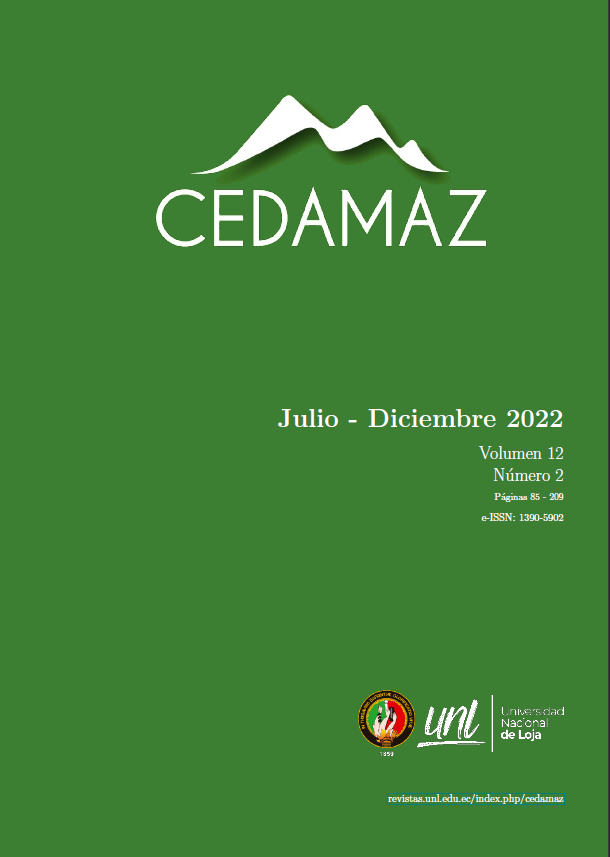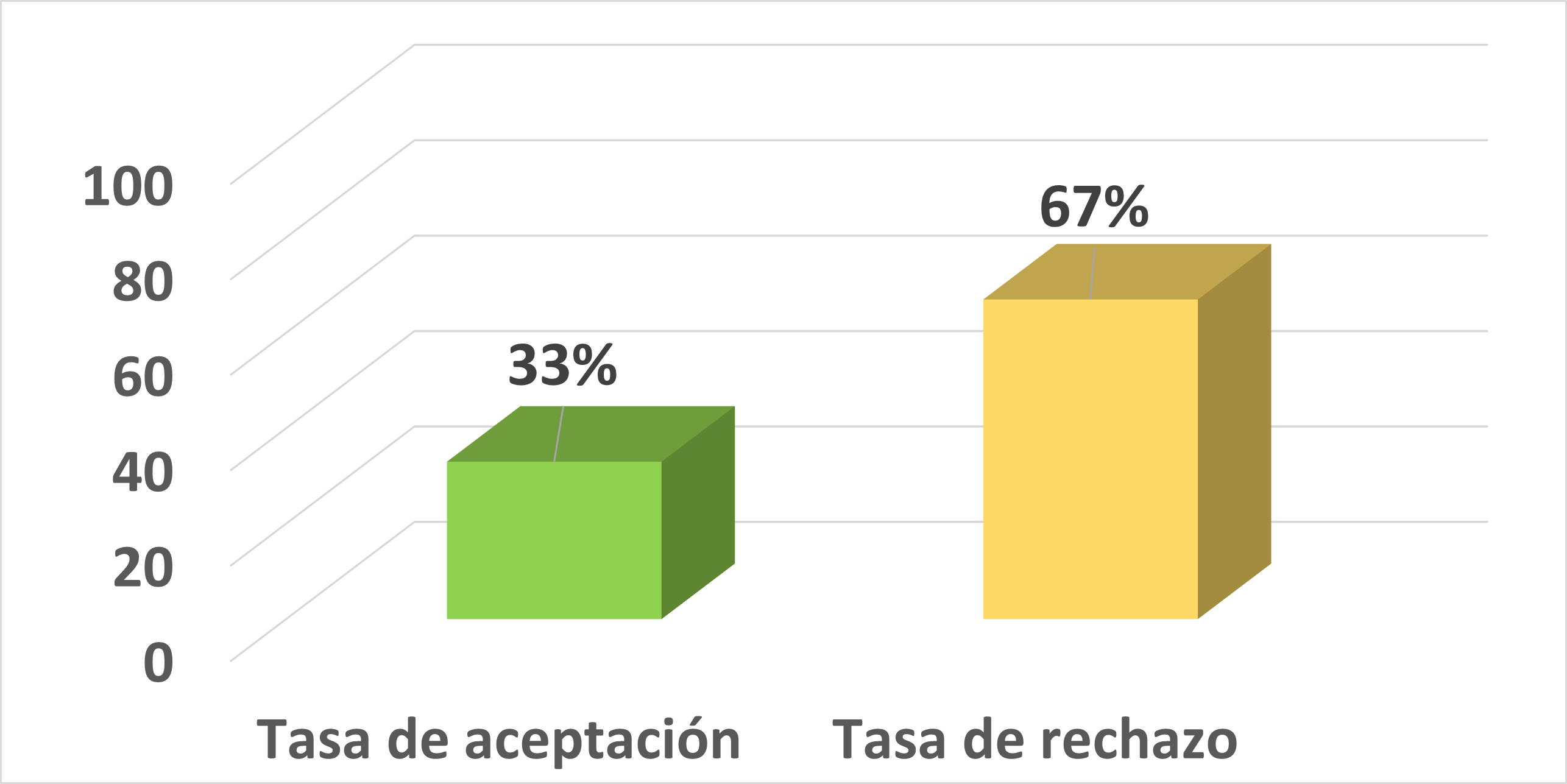Vascular flora of dry scrub in Southern Ecuador
DOI:
https://doi.org/10.54753/cedamaz.v12i2.1319Keywords:
Live forms, Loja, Andean Valleys, Dry vegetationAbstract
This study lists dry scrub species that grow in western lowlands and interandean valleys in south Ecuador. Using material from field trips spanning over two years, we were able to identify 314 species belonging to 71 families and 221 genera. The most diverse families are Asteraceae (33 sp.), Fabaceae s.l. (27 sp.) and Poaceae (19 sp.). The most diverse genera are Croton (8 sp.) Euphorbia (6 sp.), Oxalis (5 sp.) and Senna (5 sp.). 7.01% of the flora (22 sp.) is endemic to the study area, and 6.4% (20 sp.) is adventive. The dominant life form is hemycryptophyte with 85 species (27.1%). Epiphytes, with 6 species, are the life form with fewer species (1.9%). The work contributes to the knowledge about plant diversity that is highly noticeable in southern Ecuador.Metrics
References
Aguirre, Z., L.P. Kvist and O. Sánchez. 2006. Bosques secos en Ecuador y su diversidad; p. 162-187 In M. Moraes, B. Øllgaard, L. P. Kvist, F. Borchsenius and H. Balslev (ed.). Botánica Económica de los Andes Centrales. La Paz: Universidad mayor de San Andrés.
Albuja L. (Ed.). 2011. Biodiversidad de los valles secos interandinos del Ecuador. Quito: Escuela Politécnica Nacional.
Angiosperm Phylogeny Group, Chase, M. W., Christenhusz, M. J., Fay, M. F., Byng, J. W., Judd, W. S., ... Stevens, P. F. 2016. An update of the Angiosperm Phylogeny Group classification for the orders and families of flowering plants: APG IV. Botanical Journal of the Linnean Society, 181(1), 1-20. DOI: https://doi.org/10.1111/boj.12385
Austin, D.F. 1982. Convolvulaceae; p. 1- 98 In G. Harling and B. Sparre (ed.). Flora of Ecuador. Volume 15. Göteborg; Riksmuseum.
Best, B. J. and M. Kessler. 1995. Biodiversity and Conservation in Tumbesian Ecuador and Peru., Cambridge: BirdLi fe International.
Brummit, R. K. and C. E. POWELL (Ed.). 1992. Authors of plant names. A list of authors of scientific names of plants, with recommended standard forms of their names, including
abbreviations. Kew: Royal Botanical Gardens. 732 pp.
Cabrera – Cisneros, O. and AP. 2013. Euphorbia weberbaueri, Nuevo Registro para Ecuador. Boletín de la Sociedad Argentina de Botánica. 48(1): 137-141.
Cornejo, X. and H. Iltis. 2009. The Reinstatement of Beautempsia (CAPPARACEAE) and a Key to the Genera of Neotropical Capparaceae with Variously stellate or Peltate indumenta. Journal of the Botanical Research Institute of Texas 3(2): 683-689.
Cronquist, A. 1968. The evolution and classification of flowering plants. The evolution and classification of flowering plants.
Darwinion 2013. Flora del Cono Sur. Electronic Database accessible at http://www2.darwin.edu.ar. Captured on July 2013.
Dodson, C.H. and A.H. Gentry. 1991. Biological extinction in western Ecuador. Annals of Missouri Botanical Garden 78(2): 273-295. DOI: https://doi.org/10.2307/2399563
Espinosa, C.I., M. de la Cruz, A. Luzuriaga and A. Escudero. (2012). Tropical dry forest of the Ecuadorian Pacific region: Diversity, structure, function and conservation management. Ecosistemas 21(1-2):167-179.
Espinoza, G.A., E.R. Fuentes and J.D. Molina. 1988. La erosión: fenómenos naturales y acción del hombre; p. 53-64.In E.R. Fuentes and S. Prenafeta (ed.). Ecología del Paisaje en Chile Central. Santiago: Ediciones Universidad Católica de Chile.
Fryxell, P.A. 1992. Malvaceae; p. 1- 142 In G. Harling and L. Andersson (ed.). Flora of Ecuador Volume 44. Stockholm; Quito: Riksmuseum.
Fuentes, E.R. 1988. Sinopsis de paisajes de Chile central; p. 17-28 In E.R Fuentes and S. Prenafeta (ed.). Ecología del Paisaje en Chile Central. Santiago: Ediciones Universidad Católica de Chile.
Gentry, A.H. 1977. Bignoniaceae; p. 1- 173 In G. Harling and B. Sparre (ed.). Flora of Ecuador Volume 7. Götenborg: Riksmuseum.
Gutiérrez, J.R. and F.A. Squeo. 2004. Importancia de los arbustos en los ecosistemas semiáridos de Chile. Ecosistemas 13(1): 36-45.
Holm-Nielsen, L.B., P.M. Jorgensen and J.E. Lawesson. 1988. Passifloraceae; p. 1- 130. In: G. Harling and L. Andersson (ed.). Flora of Ecuador. Volume 31. Stockholm; Quito: Riksmuseum.
IPNI 2004. International plant names. Electronic database accessible at http://www.ipni.org. Captured on July 2013.
Jørgensen, P.M. and S. León-Yanez, (ed.). 1999. Catalogue of vascular plants of Ecuador. - Monographs in Systematic Botany from the Missouri Botanical Garden. 75: (I-VIII).
La Torre – Cuadros, M. and R. Linares Palomino. 2008. Mapas y clasificación de vegetación en ecosistemas estacionales: un análisis cuantitativo de los bosques secos de Piura. Revista Peruana de Biología 15(1): 31-42. DOI: https://doi.org/10.15381/rpb.v15i1.1668
López, R.P. 2003. Diversidad florística y endemismo de los valles secos bolivianos. Ecología en Bolivia 38(1): 27-60.
López, R.P., D. Larrea Alcázar and J.M. Macía. 2006. The arid and dry plant formations of South America and their floristic connections: New Data Interpretation. Darwiniana 44(1): 18-31.
Lozano, P. 2002. Los tipos de bosques en el sur del Ecuador; p. 29-49. In Z. Aguirre, J.E Madsen, E. Cotton, and H. Balslev. (ed.), Botánica Austroecuatoriana -Estudios sobre los Recursos Vegetales en las Provincias de El Oro, Loja y Zamora Chinchipe. Quito: Abya - Yala.
Maestre, F.T., J.L. Quero, N.J. Gotelli, A. Escudero, V. Ochoa, M. Delgado-Baquerizo, M. García-Gómez, M.A. Bowker, S. Soliveres, C. Escolar, P. García-Palacios, M. Berdugo, E. Valencia, B. Gozalo, A. Gallardo, L. Aguilera, T. Arredondo, J. Blones, B. Boeken, D. Bran, A.A. Conceição, O. Cabrera, M. Chaieb, M. Derak, D.J. Eldridge, C.I. Espinosa, A. Florentino, J. Gaitán, M.G. Gatica, W. Ghiloufi, S. Gómez-González, J.R. Gutiérrez, R.M. Hernández, X.
Huang, E. Huber-Sannwald, M. Jankju, M. Miriti, J. Monerris, R.L. Mau, E. Morici, K. Naseri, A. Ospina, V. Polo, AP, E. Pucheta, D.A. Ramírez-Collantes, R. Romão, M. Tighe, C. Torres-Díaz, J. Val, J.P. Veiga, D. Wang, E. Zaady. Plant species richness and ecosystem multifunctionality in global drylands. Science 335(6065): 214-218. DOI: https://doi.org/10.1126/science.1215442
Miller, J.S. and M. Gottschling. 2007. Generic classification in the Cordiaceae (Boraginales): resurrection of the genus Varronia P.Br. Taxon 56(1): 163-169.
MOBOT 2013. Tropicos. Electronic database accessible at http://www.tropicos.org. Captured on July 2013. Myers, N. 1988. Threatened biotas: “hot spots” in tropical forests. The Environmentalist 8(3):187–208. Neill D.A., Ulloa-Ulloa C. 2011. Adiciones a la flora del Ecuador: Segundo Suplemento, 2005-2010. Quito: Fundación Jatun Sacha. 202 p. DOI: https://doi.org/10.1007/BF02240252
Pennington, R.T., Prado, D.E., and C.A. Pendry, 2000. Neotropical seasonally dry forests and quaternary vegetation changes. Journal of Biogeography 27(2): 261-273 DOI: https://doi.org/10.1046/j.1365-2699.2000.00397.x
Pourrut P., O. Róvere, I. Romo and H. Villacrés. 1995. Clima del Ecuador; p 13-26 In P. Pourrut (ed.). El agua en el Ecuador: clima, precipitaciones, escorrentías. L’Institut Fra-nçais de Recherche Scientifique pour l Développement en Coopération ORSTOM.Quito
Prina, A. and G. Alfonso. 2002. La importancia de las prospecciones florísticas en la biología de la conservación. Ecosistemas 11(3). Raunkiær C. 1934. The life forms of plants and statistical plant geography. Oxford: Oxford University Press. 632 p.
Reynolds, J.F. 2001. Desertification; p. 61-78 In S. Levin (ed.). Encyclopedia of biodiversity. Volume 2. San Diego: Academic Press. DOI: https://doi.org/10.1016/B0-12-226865-2/00068-7
Reynolds, J.F. and D.M. Stafford Smith. (2002). Do humans cause deserts?; p. 1-21 In J.F Reynolds and D.M. Stafford Smith (ed.). Global desertification: do humans cause de serts? Berlin: Dahlem Workshop Report 88, Dahlem University.
Rugolo de Agrasar, Z.E. and A.S. Vega. 2004. Tripogon nicorae, a New Species and Synopsis of Tripogon (Poaceae: Chloridoideae) in America. Systematic Botany 29(4): 874-882. DOI: https://doi.org/10.1600/0363644042451125
Sierra, R., C. Cerón, W. Palacios and R. Valencia. 1999. Propuesta preliminar de un sistema de clasificación para elEcuador continental. Quito: Proyecto INEFAN/GEF. 193 p.
Suárez, L. and R. Ulloa. 1993. La diversidad biológica en el Ecuador; p. 13-24 In P. Mena and L. Suárez (ed.). La in vestigación para la conservación de la diversidad biológica en el Ecuador. Quito; EcoCiencia.
Werner F. 2009. Plantas comunes de Bosque Protector Jerusalén. Rapid Color Guide 214. Environmental Conservation Programs, Chicago: The Field Museum. Ulloa – Ulloa, C. and D.A. Neill. 2005. Cinco años de adiciones a la flora del Ecuador 1999-2004. Loja: Editorial UTPL. 75 p.
Published
How to Cite
Issue
Section
License
Copyright (c) 2022 CEDAMAZ

This work is licensed under a Creative Commons Attribution-NonCommercial-NoDerivatives 4.0 International License.
Those authors who have publications with this journal, accept the following terms:
- After the scientific article is accepted for publication, the author agrees to transfer the rights of the first publication to the CEDAMAZ Journal, but the authors retain the copyright. The total or partial reproduction of the published texts is allowed as long as it is not for profit. When the total or partial reproduction of scientific articles accepted and published in the CEDAMAZ Journal is carried out, the complete source and the electronic address of the publication must be cited.
- Scientific articles accepted and published in the CEDAMAZ journal may be deposited by the authors in their entirety in any repository without commercial purposes.
- Authors should not distribute accepted scientific articles that have not yet been officially published by CEDAMAZ. Failure to comply with this rule will result in the rejection of the scientific article.
- The publication of your work will be simultaneously subject to the Attribution-NonCommercial-NoDerivatives 4.0 International (CC BY-NC-ND 4.0)









